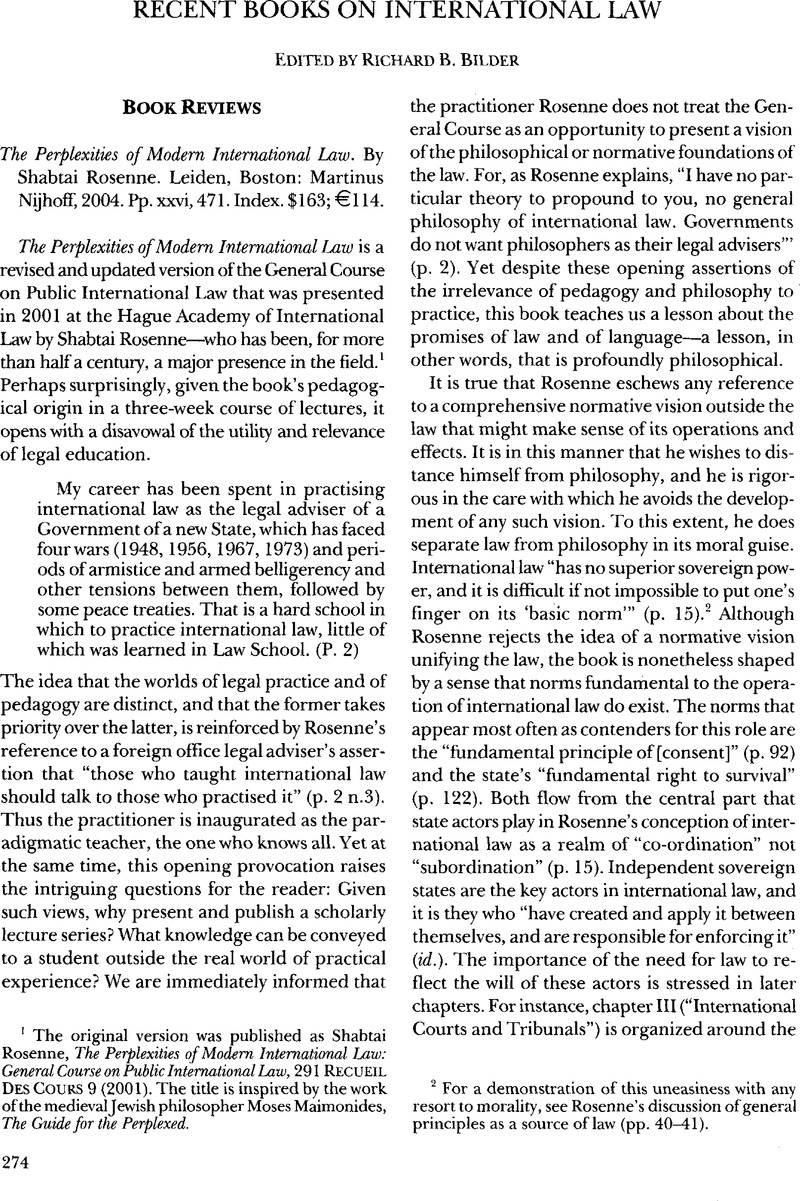No CrossRef data available.
Article contents
The Perplexities of Modern International Law. By Shabtai Rosenne. Leiden, Boston: Martinus Nijhoff, 2004. Pp. xxvi, 471. Index. $163; €114.
Published online by Cambridge University Press: 27 February 2017
Abstract

- Type
- Recent Books on International Law
- Information
- Copyright
- Copyright © American Society of International Law 2005
References
1 The original version was published as Rosenne, Shabtai, The Perplexities of Modern International Law: General Course on Public International Law, 291 Recueil Des Cours 9 (2001)Google Scholar. The title is inspired by the work ofthe medieval Jewish philosopher Moses Maimonides, The Guide for the Perplexed.
2 For a demonstration of this uneasiness with any resort to morality, see Rosenne’s discussion of general principles as a source of law (pp. 40-41).
3 I should note in passing that this chapter was marred by uncharacteristic mistakes, such as the suggestion that there is still no body to monitor the International Covenant on Economic, Social and Cultural Rights (p. 218).
4 The (now infamous) Memorandum from Assistant Attorney General Jay S. Bybee to White House Counsel Alberto R. Gonzales Regarding Standards of Conduct for Interrogation Under 18 U.S.C. §§ 2340-2340A (Aug. 1, 2002) sets out the related argument that “a nation’s right of self-defense” would justify a “government defendant” in torturing or otherwise harming “an enemy combatant during an interrogation in a manner that might arguably violate Section 2340A” of the United States Code implementing the Convention Against Torture and Other Cruel, Inhuman and Degrading Treatment or Punishment. For a summary of this and other executive branch memorandums concerning the treatment of detainees, see Sean, D. Murphy, Contemporary Practice of the United States, 98 AJIL 820 (2004)Google Scholar.
5 Korhonen, Outi, International Law Situated 223 (2000)Google Scholar.
6 See Felman, Shoshana, The Scandal of the Speaking Body 47 (2002)Google Scholar (suggesting that structure as being embedded in literature itself, which exists between “the authority of the broken promise and the authority of the promise believed in”).
7 For one version of the ideological message that accompanies a focus on individual lawyers as authors, see Reisman, Michael, Judge Shigeru Oda: A Tribute to an International Treasure, 16 Leiden J. Int’l L. 57, 59 (2003)CrossRefGoogle Scholar:
During the Cold War, totalitarian dictatorships contributed a significant number of judges to the ICJ. . . . Where judges, the myth of judicial independence notwithstanding, are subject to concealed, but effective political control, their personalities are not critical to understanding how the power process operates. Who remembers the names of Stalin’s judges, let alone produces Festschriften for them?
8 See Koskenniemi, Martti, The Silence of Law/The Voice of Justice, in International Law, The International Court of Justice and Nuclear Weapons 488,507–10 (Laurence Boisson, de Chazournes & Philippe, Sands eds., 1999)Google Scholar.
9 On the role that support for pirates played in the imperial rivalry between Spain and England, see Barbara Fuchs, Mimesis and Empire (2001).
10 To take one example (discussed at pp. 145-46), the use of the words “criminal’ and “intended or calculated” in the General Assembly Declaration on Measures to Eliminate International Terrorism, GA Res. 49/60 (Dec. 9, 1994), seems necessary to ensure that the following statement does not apply to the conduct of states:
[C]riminal acts intended or calculated to provoke a state of terror in the general public, a group of persons or particular persons for political purposes are in any circumstances unjustifiable, whatever the considerations of a political, philosophical, ideological, racial, ethnic, religious or any other nature that may be invoked to justify them.
Otherwise, some routine state actions—for example, detaining asylum seekers for indefinite periods (as a disincentive to others seeking refuge), detaining terrorist suspects without trial, or suppressing insurgencies by attacking civilian centers or refugee camps— might fall within the definition of acts that “provoke a state of terror . . . for political purposes.”
11 Gallop, Jane, Thinking Through the Body 43 (1988)Google Scholar.




